
ChatGPT [1] is a new artificial intelligence (AI) bot that you should be aware of. The technology, enables users to ask questions in normal language, to which the chatbot responds in conversational, however stilted, English. The bot recalls the flow of your conversation, use prior queries and replies to shape its subsequent responses. It derives its replies from vast amounts of internet-based data. It is capable of originality and authoritative-sounding responses. A few days after its release, over a million users are experimenting with ChatGPT.
However, its developer, the for-profit research company OpenAI, advises that ChatGPT "may occasionally provide inaccurate or misleading information," so use caution. This article examines the significance of this ChatGPT and its current state.
What is ChatGPT?
ChatGPT is a prototype dialogue-focused artificial intelligence chatbot created by OpenAI and published in November 2022 [2]. The chatbot is an advanced application of Generative AI, designed to produce human-like text responses through natural conversations. It is based on large language models that have been fine-tuned using both supervised and reinforcement learning approaches. OpenAI's GPT-3.5 language model, an enhanced version of GPT-3, served as the basic model that was refined. The output of the GPT-3 model was not compatible with both the user instructions and prompts. In summary, GPT-3 is unable of generating a user-preferred result. Through a chat, the ChatGPT application may deliver information and answer inquiries. ChatGPT is a conversational discourse model that has been trained using machine learning and artificial intelligence (AI). It comprehends human concepts, responds to spoken language, and can answer inquiries. It functions similarly to human communication. The origin of the word GPT is a Generative Pre-Trained Transformer. According to the company's announcement, the conversation style permits follow-up queries and, more crucially, acknowledges errors and rejects improper 2015 requests.
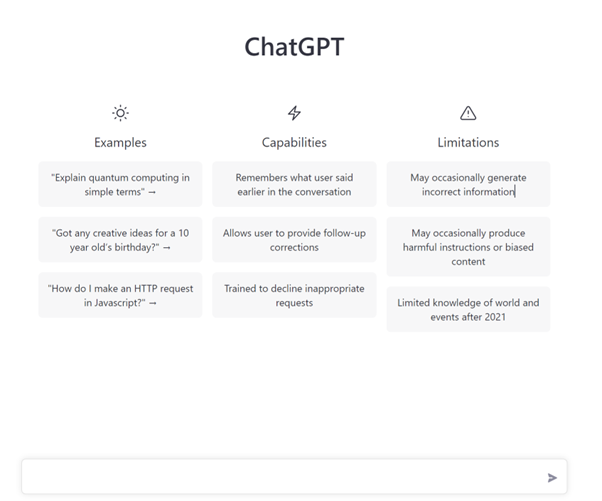
Figure shows the ChatGPT Home screen
ChatGPT has earned recognition for its thorough and intelligent comments, despite criticisms over its factual correctness. You may, for instance, ask it to answer encyclopaedia queries such as "Explaining Einstein's E=mc2 equation" or to construct a Machine Learning programme that will write a program on Random Forest for classifying heart disease.

Figure shows the output answer provided from the ChatGPT for a ML Algorithmic question
How is ChatGPT Trained?
ChatGPT was trained with the Reinforcement Learning model from Human Feedback (RLHF), employing the same procedures as InstructGPT, but with small modifications to the data collecting setup. During the first stage of the preliminary process, the original model was trained via supervised fine-tuning. This means that human AI trainers offered interactions wherein they played both sides (the user as well as an AI assistant). The model provided the trainers with model-written ideas to assist them in writing their replies.
The second phase involved the development of a reward model for use in reinforcement learning. Data for comparison was compiled from at least two different models, with the rankings of the responses serving as the quality. To obtain this data, AI trainers analysed chatbot dialogues, randomly picked a model-written sentence, sampled many possible completions, and ranked them.
In the final stage, the third one, use proximal policy optimization to make some final adjustments to the rewarded models. In addition, several iterations were carried out in order to achieve the optimum outcomes.
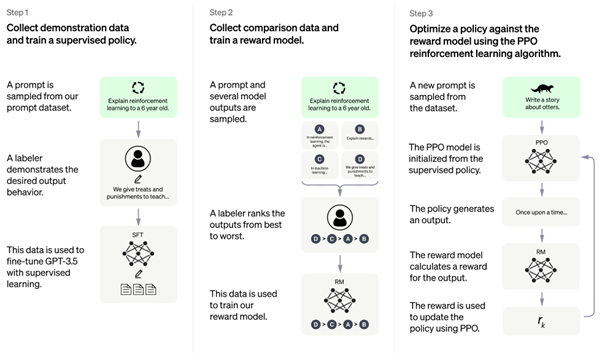
Figure shows the Steps of ChatGPT trained with Reinforcement Learning
Features of ChatGPT
• ChatGPT can recall previous comments made in a chat and relay them to the user using its unique memory.
• Defining, explaining, and summarising complicated concepts and ideas
• Producing human-like writing in response to provided instructions, such as summaries, and articles.
• It can comprehend and communicate using natural language.
• Recognizing things and concepts inside a document and giving further information about them
• Translating literature from one language to some other
• Offering comments and recommendations based on the feedback provided
• Responding to inquiries on a variety of subject areas, including history, science, literature, and current events
Some of use-cases that ChapGPT can do
Let's look at a few of the best use cases of ChatGPT:
• Explaining and resolving programming errors
Upon observing the fascinating OpenAI tool, an error question from an anonymous user from stack overflow was captured and integrated into ChatGPT [2].


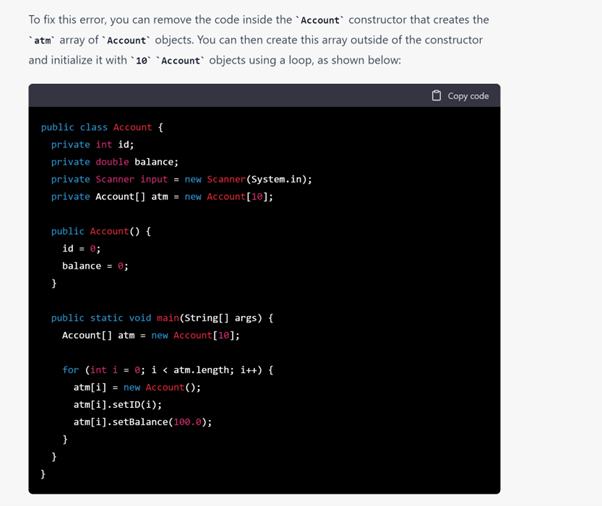
Figures shows the potential of problem-solving skill from ChatGPT
• Clear Answers (responses from ChatGPT) for the Questions

Figure shows the Clarity of speech from ChatGPT related to the pitch presentation
• Creating AI art prompts from ChatGPT

Now, add the ChatGPT description to the prompt
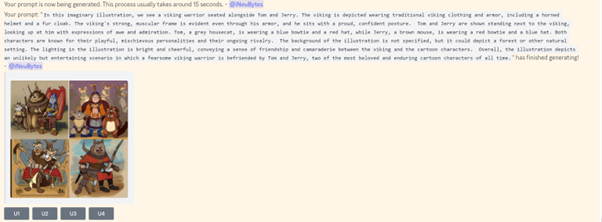
Figures shows the AI art prompts based on Text Descriptions
• Creative writing
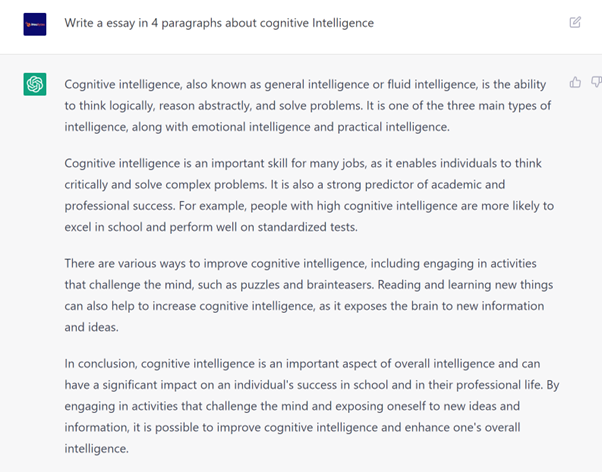
Figure shows the Content Writing Ability from ChatGPT
• And many more
Ethical Risks of ChatGPT
GPT-like AI foundation models offer a monumental advancement in the area of AI. They provide distinct advantages, such as significant cost and time savings when creating domain-specific models. Nonetheless, they bring hazards and ethical problems, particularly those related to:
• Complexity: billions or perhaps trillions of parameters are required for large models. Due to the required computational resources, it is unfeasible for most enterprises to train these models, which may be costly and environmentally harmful.
• Intellectual property: This model has been trained on a database of creative works, and the legal precedence for reusing this content if it was obtained from intellectual property of someone else is yet unknown.
Foundation models reduce the expense of content development, making it easier to produce deepfakes that are almost identical to the original. This includes voice and video imitation, as well as bogus art and targeted attacks. Serious ethical problems may create reputational injury or political strife.
• Consolidation of power: Such models were developed mostly by the largest technological firms, who have made substantial expenditures in R&D and cultivated significant AI expertise. This has led to a consolidation of power within a few large, well-resourced companies, which may in the future result in a serious imbalance.
• Black-box nature: Due to its black-box nature, such models still require rigorous training and can produce unsatisfactory outcomes. Frequently, it is unknown what factbase algorithms are attributing answers to, which might perpetuate bias in subsequent datasets. The homogeneity of such models may result in a single failure point.
Now Serious Question lies Ahead: Is ChatGPT a threat for Humans because of AI?
As with the majority of technical advances, including the internet itself, this will alter our economy and job market. In the same way that each Industrial Revolution has altered the nature of our job, we will eventually adjust to the new instruments at our reach and the new economic structure. We feel this transformation is significant and will create new opportunities in AI. ChatGPT might one day become the go-to helper for assisting us with routine activities. But before we let technology into our life, certain technical aspects must be resolved, such as ensuring that AI/ML models were trained and developed appropriately. According to OpenAI's Altman, human-like intelligence in computers might be in the horizon, so stay tuned.
References
[1] ChatGPT. Online available at: https://chat.openai.com/chat, Accessed on 12 November 2022
[2] ChatGPT: Optimizing Language Models for Dialogue, OpenAI. Online available at: https://openai.com/blog/chatgpt/, Accessed on 12 November 2022